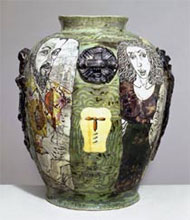
| HOME |
| NERVE |
| REVIEWS |
| ARCHIVE |
| EVENTS |
| LINKS |
| ABOUT US |
| CONTRIBUTORS |
| BACK ISSUES |
| CONTACT US |
 A
Secret History of Clay: From Gauguin to Gormley
A
Secret History of Clay: From Gauguin to Gormley
Exhibition at Tate Liverpool from 28th May – 30th August
Reviewed by Barbara Jones
This chronologically arranged collection of art work made from, or making use of, various forms of clay holds many surprises from the outset. We are told to begin by observing Gauguin’s “Double-vase Decorated with Breton Figure” of 1886 and this is the first of many examples of ceramic objects which actually defy their function since it cannot be used to hold flowers. Bereft of purpose it becomes a sculpture.
This first room contains many works by artists who are more famous for art made using other media;Matisse, Nolde and Vlaminck to name 3. They seem to revel in the fact that the firing process heightens and intensifies the vibrant colours which they traditionally used in their paintings.
As you move through into the next room the subject matter shifts and becomes more socially and politically engaged. Plates decorated with political slogans, a Fascist-black “Head of Mussolini” (1933) and a gilded terracotta “Gas Mask” (1932) seem to show a return to using clay for a purpose, albeit one of persuasion rather than function.
Further on into the exhibition we see artists “playing around” with the medium of clay. For example Lucio Fontana tearing at the clay to produce figures. And Picasso manipulating soft, thrown “pots” to make forms which are morphing into other forms. But, my particular favourite is the work produced by Joan Miro. He created childlike forms and figures and then allowed the unpredictability of the firing process to dictate the resulting sculpture. His terracotta “Untitled” of 1980 and “Round Plate” of 1977, which looks like a drawing scrawled into sand, are perfect examples of his exploitation of the raw, tactile qualities of this material.
At this point on your tour of the show you begin to get itchy fingers which long to touch and enjoy the tactile experience for yourself. This desire is fulfilled by an installation by Nobuo Sekine entitled “Phase of Nothingness” which consists of three lumps of oil clay dumped onto the floor of the gallery which visitors are invited to mould figures or shapes into. They are already covered in many faces and creatures and writhing forms which “itchy fingers” have created, reminiscent of the idea of God forming the first man, as well as Antony Gormley’s “Field” of 35,000 clay figures currently on show on the second floor. It would be interesting to film the progression of this work in a similar way to the “stop/frame animation” video, “God Bless America” (2002) by Tadasu Takamui, on show in the final room of the exhibition.
This is a large and varied exhibition which defies a concise description. It’s amazing to observe the different ways in which artists have used clay, whether it be Andy Goldsworthy’s “Clay Wall” with it’s beautiful cracks and crevices, or Richard Long’s Mississippi Mud on paper, or Chen Zhen’s “Purification Room” where everything is enshrouded in a layer of clay slip. I particularly enjoyed the pieces with which you could physically engage, including Clare Twomey’s “Consciousness/Conscience” (2004), a layer of fine bone china tiles which are placed on the floor across the entrance to the final room. As you walk on the broken tiles they become increasingly smashed and disintegrate into powder which is carried around the gallery on people’s shoes. Once you realise that you have been given permission to destroy a piece of art it’s so liberating that you want to return and stamp on the tiles again and again!
Finally, I must mention an amusing twist in the tale of one of the works by a young Dutch artist called Jeppe Hein entitled “Please Do Not Touch the Artwork” (2004). A ceramic plate, bearing the title, is displayed on the wall with the intention that, if you approach too closely, you will trigger a sensor which will cause the plate to smash onto the floor. Unfortunately, due to the dreaded “Health and Safety” rules, this cannot be allowed to occur randomly so a special “performance” is staged each day whereby a gallery assistant activates the sensor in a controlled demonstration and the smashed plate then remains on the floor until the next day!
I found my visit to this exhibition to be very enjoyable and highly informative and I would recommend you to go and experience it for yourself. It continues until 30th August.